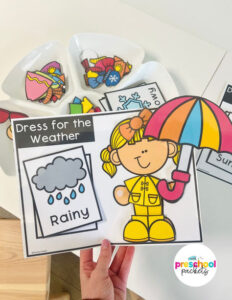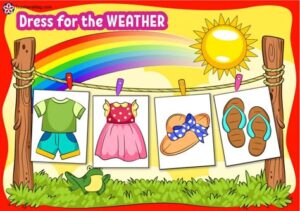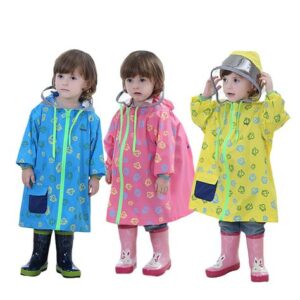Weather plays a significant role in determining what children wear, and it can influence their comfort, style, and functionality. As parents, we are often faced with the challenge of dressing our little ones in a way that keeps them both stylish and practical for the changing seasons. Understanding how different weather conditions impact kids’ fashion choices can help us make informed decisions when shopping for our children’s wardrobes. In this article, we’ll explore how weather affects kids’ fashion and provide some tips on dressing children appropriately for various weather conditions.
1. Dressing for Cold Weather: Layering is Key
When temperatures drop, dressing kids in layers is essential. Not only does layering help to keep them warm, but it also allows for flexibility—kids can easily add or remove layers depending on the temperature and their activity level. During colder months, items like jackets, coats, sweaters, and scarves become key wardrobe staples.
- Outerwear: For winter weather, insulated jackets or down coats are the go-to choice for keeping kids warm. These items need to be both stylish and functional, with added features like hoods, zippers, and waterproof or windproof materials to protect against the elements.
- Layering Pieces: In addition to coats, layering pieces like thermal shirts, fleece-lined leggings, and long-sleeve tops are necessary for extra warmth. Sweaters made from wool or knit fabrics are also great for retaining heat without sacrificing style.
- Footwear: Winter boots with insulation, waterproofing, and traction are ideal for snowy or icy conditions. Boots need to be durable and offer protection while still being comfortable for kids who may spend a lot of time playing outside.
- Accessories: Hats, mittens, and scarves are essential for keeping kids’ extremities warm during the coldest months. Stylish knit beanies or ear-flap hats, paired with colorful scarves, add an extra layer of fun to any winter outfit.
2. Dressing for Hot Weather: Comfort and Breathability

When the temperature rises, comfort becomes the primary concern when choosing clothes for kids. Hot weather calls for breathable, lightweight fabrics that allow kids to stay cool and comfortable throughout the day. Parents often face the challenge of balancing style and practicality while ensuring that their children are adequately protected from the sun.
- Lightweight Fabrics: Cotton, linen, and bamboo fabrics are ideal for hot weather, as they are breathable and absorb moisture, keeping kids cool and dry. Avoiding heavy fabrics like denim or wool ensures that kids stay comfortable even on the hottest days.
- Shorts and Dresses: Summer wardrobes typically include shorts, skirts, and dresses. These options allow for better airflow and freedom of movement, which is perfect for active kids. Dresses with fun prints or graphic tees paired with shorts can create stylish, age-appropriate looks.
- Sun Protection: In hot weather, it’s crucial to protect kids from harmful UV rays. Lightweight long-sleeve shirts, wide-brimmed hats, and UV-protective swimwear are essential when heading outdoors. Many brands now offer sun-protective clothing with built-in UPF (Ultraviolet Protection Factor) to help keep kids safe from the sun.
- Footwear: Sandals, flip-flops, or breathable sneakers are ideal choices for summer footwear. It’s important to ensure that shoes are comfortable and provide adequate support, especially for children who spend a lot of time running around.
3. Dressing for Rainy Weather: Waterproof and Functional
Rainy weather poses a unique challenge for kids’ fashion choices. Parents need to ensure that kids stay dry and comfortable while still maintaining a sense of style. The right choice of clothing and accessories can make rainy days a lot more enjoyable for children.
- Rain Jackets and Ponchos: Waterproof rain jackets are a must-have during the rainy season. These jackets not only protect kids from the rain but also come in fun, bright colors and patterns that appeal to children. Ponchos can also be a great alternative for keeping kids dry without the bulkiness of a traditional raincoat.
- Waterproof Footwear: Waterproof boots are essential for rainy days. Rubber boots or galoshes are not only practical for keeping feet dry but can also be found in an array of fun colors and prints. Pairing them with fun socks can add an extra layer of personality to the outfit.
- Umbrellas and Accessories: A kid-friendly umbrella with colorful prints or favorite characters can make rainy days more enjoyable. In addition, hats with wide brims can help keep rain out of children’s eyes, ensuring better visibility during a downpour.
4. Dressing for Transitional Seasons: Spring and Fall

Spring and fall can be tricky seasons to dress for because the weather can fluctuate dramatically. In these transitional periods, layering is again key. Mornings may be chilly, but afternoons could warm up quickly, requiring clothing that can be adjusted to changing temperatures.
- Light Jackets and Cardigans: Lightweight jackets, cardigans, and sweaters are essential for the spring and fall wardrobe. These layers can easily be added or removed, depending on the temperature. A denim jacket or a trench coat can be both stylish and functional for these in-between seasons.
- Pants and Leggings: While shorts might be appropriate during the warmer parts of the day, it’s also important to have pants or leggings on hand for cooler mornings. Comfortable, stretchy fabrics work well for kids who are active and enjoy playing outdoors.
- Footwear: Sneakers are perfect for spring and fall, offering comfort for outdoor activities without compromising on style. A versatile pair of shoes that can handle different weather conditions is a great investment for these unpredictable seasons.
- Layering for Flexibility: For both spring and fall, layering shirts or lightweight sweaters under jackets or cardigans allows kids to add or remove clothing depending on the temperature. Layering also creates fun and stylish outfit combinations, allowing for versatility in their wardrobe.
5. Dressing for Extreme Weather: Hot Summers and Cold Winters
In regions where extreme weather conditions prevail, it’s crucial to have specialized clothing for both hot summers and harsh winters. Extreme cold or heat can place additional stress on kids’ comfort and health, so investing in high-quality seasonal items is important.
- Heatwaves: For extreme heat, ensure your child wears loose-fitting, breathable clothing. Fabrics like cotton, linen, and moisture-wicking materials help keep the body cool. Always make sure your child is drinking enough water and wearing sunscreen.
- Blizzards and Heavy Snow: During extremely cold winters, insulated snow suits, gloves, and boots with a high level of warmth retention are necessary. Layering underneath with thermal base layers will help retain body heat and ensure your child stays warm when playing outside.
Conclusion

Weather significantly impacts kids’ fashion choices, influencing everything from fabric selection to layering techniques. Whether dealing with hot summer days, chilly winter weather, rainy spring showers, or transitional fall temperatures, parents must find clothing that balances comfort, style, and functionality. By understanding how weather affects children’s clothing needs, you can make better fashion choices for your little ones and ensure they’re always dressed appropriately for whatever the forecast may bring.


